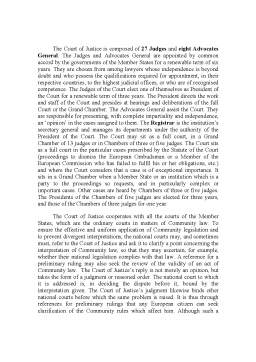Extras din referat
Court of Justice is composed of 27 Judges and eight Advocates General. The Judges and Advocates General are appointed by common accord by the governments of the Member States for a renewable term of six years. They are chosen from among lawyers whose independence is beyond doubt and who possess the qualifications required for appointment, in their respective countries, to the highest judicial offices, or who are of recognised competence. The Judges of the Court elect one of themselves as President of the Court for a renewable term of three years. The President directs the work and staff of the Court and presides at hearings and deliberations of the full Court or the Grand Chamber. The Advocates General assist the Court. They are responsible for presenting, with complete impartiality and independence, an ‘opinion’ in the cases assigned to them. The Registrar is the institution’s secretary general and manages its departments under the authority of the President of the Court. The Court may sit as a full court, in a Grand Chamber of 13 judges or in Chambers of three or five judges. The Court sits as a full court in the particular cases prescribed by the Statute of the Court (proceedings to dismiss the European Ombudsman or a Member of the European Commission who has failed to fulfil his or her obligations, etc.) and where the Court considers that a case is of exceptional importance. It sits in a Grand Chamber when a Member State or an institution which is a party to the proceedings so requests, and in particularly complex or important cases. Other cases are heard by Chambers of three or five judges. The Presidents of the Chambers of five judges are elected for three years, and those of the Chambers of three judges for one year.
The Court of Justice cooperates with all the courts of the Member States, which are the ordinary courts in matters of Community law. To ensure the effective and uniform application of Community legislation and to prevent divergent interpretations, the national courts may, and sometimes must, refer to the Court of Justice and ask it to clarify a point concerning the interpretation of Community law, so that they may ascertain, for example, whether their national legislation complies with that law. A reference for a preliminary ruling may also seek the review of the validity of an act of Community law. The Court of Justice’s reply is not merely an opinion, but takes the form of a judgment or reasoned order. The national court to which it is addressed is, in deciding the dispute before it, bound by the interpretation given. The Court of Justice’s judgment likewise binds other national courts before which the same problem is raised. It is thus through references for preliminary rulings that any European citizen can seek clarification of the Community rules which affect him. Although such a reference can be made only by a national court, all the parties to the proceedings before that court, the Member States and the European institutions may take part in the proceedings before the Court of Justice. In that way, several important principles of Community law have been established by preliminary rulings, sometimes in reply to questions referred by national courts of first instance.
These actions enable the Court of Justice to determine whether a Member State has fulfilled its obligations under Community law. Before bringing the case before the Court of Justice, the Commission conducts a preliminary procedure in which the Member State is given the opportunity to reply to the complaints against it. If that procedure does not result in the Member State terminating the failure, an action for infringement of Community law may be brought before the Court of Justice. The action may be brought by the Commission — as, in practice, is usually the case — or by a Member State. If the Court finds that an obligation has not been fulfilled, the State must bring the failure to an end without delay. If, after a further action is brought by the Commission, the Court of Justice finds that the Member State concerned has not complied with its judgment, it may impose on it a fixed or periodic financial penalty.
Actions for annulment
By an action for annulment, the applicant seeks the annulment of a measure (regulation, directive or decision) adopted by an institution. The Court of Justice has exclusive jurisdiction over actions brought by a Member State against the European Parliament and/or against the Council (apart from Council measures in respect of State aid, dumping and implementing powers) or brought by one Community institution against another. The Court of First Instance has jurisdiction, at first instance, in all other actions of this type and particularly in actions brought by individuals.
Preview document
Conținut arhivă zip
- The Court of Justice.doc
























